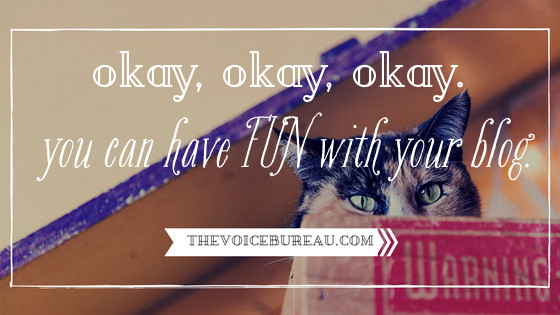I’m really bad at awkward silences.
Don’t get me wrong, I love silence. In a house with two girls of pre-preschool age, it’s hard to come by. I cherish every single second of ear-ringingly empty quiet (at least until a cat knocks something over or the baby wakes up). But I’m talking about those lulls in conversation when it’s obvious that someone needs to speak up.
And oh, I speak up. For a textbook introvert, I do a whole lot of speaking up.
When faced with the prospect of an awkward silence, I have a habit of filling in the quiet with every little detail of my life. All those things I’d rather not share? The embarrassing stories? Deepest secrets? Private thoughts? Suddenly, I can’t hold them back.
Do you do this? It’s awful, isn’t it? I’m a relatively private person by nature, but one awkward silence and I’m — to steal a phrase from every mafia movie ever — singing like a canary.
In a lot of ways, the internet is the ultimate awkward silence. Even if a blog post ends up with a hundred comments, a lively discussion, a viral social media presence, when you’re sitting down to write, it’s just you and your writing playlist/Netflix binge. It’s a perfect storm for oversharing.
To top it off, there’s a pretty good chance you want to get a little personal in your writing. In fact, Intimacy is one of the most common Voice Values for our clients. It’s one of the reasons we’ve left our day jobs, to create a career with a more human side, favoring connections over the stability of a regular paycheck. (Yes, even us introverts.) It’s why so many of us prefer to work one-on-one or in small groups. It’s why we’ve scaled our businesses to retain that personal connection. Intimacy and authenticity is what we’re all about.
So how do you foster intimacy with your readers without feeling quite so…naked?
Well, first of all, you need to be intentional.
You’re bound to share some things about yourself, no matter what. You want to share a bit, if you hope to connect with your readers and potential clients. Especially if your brand features you as a person, it’s almost impossible to avoid — at least without coming off as dry and distant. Even if you don’t have what would be considered a “personality brand,” giving your business a face helps your Right Person understand why they’re hiring you. It makes working with you about working with you, and features you, yourself, in particular, as an important part of the process. (Which you are.)
So what do you want to share with your readers? Think about your life. What areas will your Right Person naturally understand?
Do they share your love of hiking, or will they admire your encyclopedic knowledge of craft beer? Maybe they’re homebodies who would love to know that you knit, even if they prefer a good book for their cozy evenings by the fire. What do you do or love or know that gives them some insight into who you are as a person, outside of your work? You may have a hundred interests, but focusing on just a few key pieces helps create a more cohesive picture of who you are. Start there. You can always share more and build on this as you go.
Now, what’s off-limits?
It’s okay to keep some things to yourself. If you don’t want to share your children or your sexual preference or your health struggles with your readers, that’s okay. Hey, if you don’t want to share your knitting or hiking or beer drinking, that’s okay too. It’s also okay if these personal details become the cornerstone of your brand. It’s really up to you to decide what feels right to share and what belongs to you alone. But decide that before you write a single word, or there’s a very good chance you’re going to find yourself with the awkward silence of a blank page, and suddenly every childhood trauma is spilled out in front of you and all you wanted to do was share a recipe for quinoa salad.
Transparency is not the same as intimacy. There is no reason to feel you need to share everything in order to foster an authentic connection with your readers. It doesn’t make it any less authentic. It doesn’t make it any less intimate. It just means you’ve created healthy boundaries. And that’s a good thing!
No matter what you choose to share, though, be sure to keep it real. If you’re hiding your personality or pretending to be someone you’re not, you’ll be maintaining a persona that simply isn’t you, and that’s not sustainable in the long run. Before you know it, you’ll find that you’re avoiding your readers because you don’t want them to figure out that your public face and your private face don’t match up. You’ll be working with clients who are drawn to this false sense of you — and, more importantly, scaring off the very people who would line up around the block for what you really have to offer. When you choose to be just who you are, it’s easier to communicate, to connect. What you share doesn’t need to be a complete picture of who you are, but it does need to be you.
The other side of intimacy, of course, is listening.
If you’re just spilling what you’re all about, you’re not really fostering intimacy, you’re just creating a confessional. Help your readers feel seen. What do you know about them? Is there something they have in common? Something they’re going through?
Intimacy is about recognizing and highlighting the camaraderie you share with your readers and clients. It’s understanding them and building a relationship — a give-and-take that happens over time. It’s not about exposing your deepest secrets in one frantic ramble to fill the silence. When you’re intentional about what parts of yourself you want to make public, and when you take the time to listen and learn about your readers, you create a genuine rapport.
Keep it authentic. Keep it reciprocal. And, if it’s private, keep it to yourself.
In the comments, I’d love to hear:
How do you cultivate intimacy with your readers? Do you have a tendency to overshare, or to undershare?
{ 4 comments }





 Hello, you.
Hello, you.